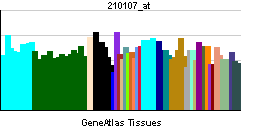CLCA1
| Chloride channel, calcium activated, family member 1 | |||||||||||
|---|---|---|---|---|---|---|---|---|---|---|---|
| Identifiers | |||||||||||
| Symbols | CLCA1 ; CaCC | ||||||||||
| External IDs | Template:OMIM5 Template:MGI HomoloGene: 984 | ||||||||||
| |||||||||||
| RNA expression pattern | |||||||||||
 | |||||||||||
| More reference expression data | |||||||||||
| Orthologs | |||||||||||
| Template:GNF Ortholog box | |||||||||||
| Species | Human | Mouse | |||||||||
| Entrez | n/a | n/a | |||||||||
| Ensembl | n/a | n/a | |||||||||
| UniProt | n/a | n/a | |||||||||
| RefSeq (mRNA) | n/a | n/a | |||||||||
| RefSeq (protein) | n/a | n/a | |||||||||
| Location (UCSC) | n/a | n/a | |||||||||
| PubMed search | n/a | n/a | |||||||||
Chloride channel, calcium activated, family member 1, also known as CLCA1, is a human gene.[1]
This gene encodes a member of the calcium sensitive chloride conductance protein family. To date, all members of this gene family map to the same region on chromosome 1p31-p22 and share a high degree of homology in size, sequence, and predicted structure, but differ significantly in their tissue distributions. The encoded protein is expressed as a precursor protein that is processed into two cell-surface-associated subunits, although the site at which the precursor is cleaved has not been precisely determined. The encoded protein may be involved in mediating calcium-activated chloride conductance in the intestine.[1]
References
Further reading
- Hume JR, Duan D, Collier ML; et al. (2000). "Anion transport in heart". Physiol. Rev. 80 (1): 31–81. PMID 10617765.
- Pauli BU, Abdel-Ghany M, Cheng HC; et al. (2001). "Molecular characteristics and functional diversity of CLCA family members". Clin. Exp. Pharmacol. Physiol. 27 (11): 901–5. PMID 11071307.
- Gruber AD, Elble RC, Ji HL; et al. (1999). "Genomic cloning, molecular characterization, and functional analysis of human CLCA1, the first human member of the family of Ca2+-activated Cl- channel proteins". Genomics. 54 (2): 200–14. doi:10.1006/geno.1998.5562. PMID 9828122.
- Agnel M, Vermat T, Culouscou JM (1999). "Identification of three novel members of the calcium-dependent chloride channel (CaCC) family predominantly expressed in the digestive tract and trachea". FEBS Lett. 455 (3): 295–301. PMID 10437792.
- Dias Neto E, Correa RG, Verjovski-Almeida S; et al. (2000). "Shotgun sequencing of the human transcriptome with ORF expressed sequence tags". Proc. Natl. Acad. Sci. U.S.A. 97 (7): 3491–6. PMID 10737800.
- Liu QH, Williams DA, McManus C; et al. (2000). "HIV-1 gp120 and chemokines activate ion channels in primary macrophages through CCR5 and CXCR4 stimulation". Proc. Natl. Acad. Sci. U.S.A. 97 (9): 4832–7. doi:10.1073/pnas.090521697. PMID 10758170.
- Toda M, Tulic MK, Levitt RC, Hamid Q (2002). "A calcium-activated chloride channel (HCLCA1) is strongly related to IL-9 expression and mucus production in bronchial epithelium of patients with asthma". J. Allergy Clin. Immunol. 109 (2): 246–50. PMID 11842292.
- Greenwood IA, Miller LJ, Ohya S, Horowitz B (2002). "The large conductance potassium channel beta-subunit can interact with and modulate the functional properties of a calcium-activated chloride channel, CLCA1". J. Biol. Chem. 277 (25): 22119–22. doi:10.1074/jbc.C200215200. PMID 11994272.
- Abdel-Ghany M, Cheng HC, Elble RC, Pauli BU (2002). "Focal adhesion kinase activated by beta(4) integrin ligation to mCLCA1 mediates early metastatic growth". J. Biol. Chem. 277 (37): 34391–400. doi:10.1074/jbc.M205307200. PMID 12110680.
- Loewen ME, Bekar LK, Gabriel SE; et al. (2002). "pCLCA1 becomes a cAMP-dependent chloride conductance mediator in Caco-2 cells". Biochem. Biophys. Res. Commun. 298 (4): 531–6. PMID 12408984.
- Zhou Y, Shapiro M, Dong Q; et al. (2003). "A calcium-activated chloride channel blocker inhibits goblet cell metaplasia and mucus overproduction". Novartis Found. Symp. 248: 150–65, discussion 165-70, 277–82. PMID 12568493.
- Abdel-Ghany M, Cheng HC, Elble RC; et al. (2004). "The interacting binding domains of the beta(4) integrin and calcium-activated chloride channels (CLCAs) in metastasis". J. Biol. Chem. 278 (49): 49406–16. doi:10.1074/jbc.M309086200. PMID 14512419.
- Ota T, Suzuki Y, Nishikawa T; et al. (2004). "Complete sequencing and characterization of 21,243 full-length human cDNAs". Nat. Genet. 36 (1): 40–5. doi:10.1038/ng1285. PMID 14702039.
- Hegab AE, Sakamoto T, Uchida Y; et al. (2004). "CLCA1 gene polymorphisms in chronic obstructive pulmonary disease". J. Med. Genet. 41 (3): e27. PMID 14985398.
- Kamada F, Suzuki Y, Shao C; et al. (2005). "Association of the hCLCA1 gene with childhood and adult asthma". Genes Immun. 5 (7): 540–7. doi:10.1038/sj.gene.6364124. PMID 15318163.
- Ritzka M, Stanke F, Jansen S; et al. (2005). "The CLCA gene locus as a modulator of the gastrointestinal basic defect in cystic fibrosis". Hum. Genet. 115 (6): 483–91. doi:10.1007/s00439-004-1190-y. PMID 15490240.
- Gibson A, Lewis AP, Affleck K; et al. (2005). "hCLCA1 and mCLCA3 are secreted non-integral membrane proteins and therefore are not ion channels". J. Biol. Chem. 280 (29): 27205–12. doi:10.1074/jbc.M504654200. PMID 15919655.
- Jeong SM, Park HK, Yoon IS; et al. (2005). "Cloning and expression of Ca2+-activated chloride channel from rat brain". Biochem. Biophys. Res. Commun. 334 (2): 569–76. doi:10.1016/j.bbrc.2005.06.122. PMID 16023076.
| This protein-related article is a stub. You can help Wikipedia by expanding it. |